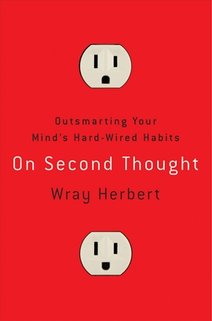
15 Sep 2010 01:30:16
Some seem to be inherited from the needs of primitive humans struggling for survival eons ago on the savannas of East Africa. Inapplicable to the 21st century, they can sometimes make trouble unless a second thought outsmarts them.
Here's an imaginary example that the text seems to suggest, but doesn't explicitly adopt:
Thousands if not millions of years ago, when the ancestors of today's mothers began to cuddle their babies, the babies associated them with body heat, food and entertainment. That appreciation of warmth has spread over the millennia to many aspects of human life, including language.
Imagine: Your new boyfriend is known as the hottest young man in town. He's affectionate, amusing and pays for meals. But before you hint about an engagement ring, have you considered how he qualifies as a future parent and lifelong partner?
Rushing into new relationships may have been useful to primitive tribes wanting to survive by increasing their populations. In our day, it can bring emotional disasters, sometimes avoidable by taking slow second thoughts about long-term compatibility.
"On Second Thought" has 20 chapters, each devoted to one heuristic. Some are apparently based on problems of primitive man — keeping a distance from tigers, for example. The author calls that one "The Mapmaker's Heuristic." Being chased by a tiger is not a worry for most people these days but we still unconsciously equate safety with distance.
We "find an airplane crash in our own neighborhood much more upsetting than a crash 3,000 miles away," he points out.
Some readers may find the book difficult to read, with its careful detailing of psychological tests. But the author has salted it with contemporary references and details of his personal decisions that humanize what might have been a dry technical account.
The last chapter suggests how in some circumstances the most satisfying decision may be to make no decision at all.
In soccer, a penalty kick, which may determine the winner of a close game, is hard for a goalkeeper to defend against. Herbert has found statistics to show that when the ball comes hurtling in toward a score and the goalie jumps to the left, he stops 14.2 percent of the shots. When he moves to the right, he succeeds 12.6 percent of the time.
When he just stands to defend the middle of the goal, the proportion of saves goes up to 33.3 percent. But only 6 percent of the goalies do that. Crises may have impelled primitive man to action — any action — and he wasn't good at calculating percentages.
Most of today's soccer goalkeepers apparently still get satisfaction out of a rush to act, even if they know the action is likely to fail.
Here's an imaginary example that the text seems to suggest, but doesn't explicitly adopt:
Thousands if not millions of years ago, when the ancestors of today's mothers began to cuddle their babies, the babies associated them with body heat, food and entertainment. That appreciation of warmth has spread over the millennia to many aspects of human life, including language.
Imagine: Your new boyfriend is known as the hottest young man in town. He's affectionate, amusing and pays for meals. But before you hint about an engagement ring, have you considered how he qualifies as a future parent and lifelong partner?
Rushing into new relationships may have been useful to primitive tribes wanting to survive by increasing their populations. In our day, it can bring emotional disasters, sometimes avoidable by taking slow second thoughts about long-term compatibility.
"On Second Thought" has 20 chapters, each devoted to one heuristic. Some are apparently based on problems of primitive man — keeping a distance from tigers, for example. The author calls that one "The Mapmaker's Heuristic." Being chased by a tiger is not a worry for most people these days but we still unconsciously equate safety with distance.
We "find an airplane crash in our own neighborhood much more upsetting than a crash 3,000 miles away," he points out.
Some readers may find the book difficult to read, with its careful detailing of psychological tests. But the author has salted it with contemporary references and details of his personal decisions that humanize what might have been a dry technical account.
The last chapter suggests how in some circumstances the most satisfying decision may be to make no decision at all.
In soccer, a penalty kick, which may determine the winner of a close game, is hard for a goalkeeper to defend against. Herbert has found statistics to show that when the ball comes hurtling in toward a score and the goalie jumps to the left, he stops 14.2 percent of the shots. When he moves to the right, he succeeds 12.6 percent of the time.
When he just stands to defend the middle of the goal, the proportion of saves goes up to 33.3 percent. But only 6 percent of the goalies do that. Crises may have impelled primitive man to action — any action — and he wasn't good at calculating percentages.
Most of today's soccer goalkeepers apparently still get satisfaction out of a rush to act, even if they know the action is likely to fail.

